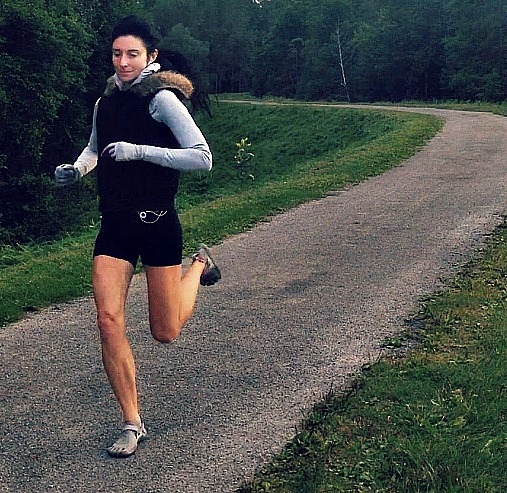Mounting evidence has found that barefoot-like running shoes, such as the Vibram Five Fingers have enormous health benefits such as improving dynamic stability, limiting impact to safer levels during walking and running, optimizing global biomechanics, and most importantly, improving foot/arch strength, making the foot/ankle complex more resilient.
The thin sole and zero cushioning/support increases plantar sensory feedback thereby creating a more stable surface for walking and running. Moreover, the Vibram Five Fingers promote innate responses of the body such as increased knee and hip flexion which is the body’s natural way of reducing loading and impact.
In fact, the positive attributes of barefoot-like running shoes on biomechanics could double a runners efficiency, economically and mechanically, researchers predict. But this is not the case for the traditional running shoe.
Why Traditional Running Shoe Manufactures Should Get Sued
Past reports have shown that the traditional running shoe reduced hip and knee flexion which in turn amplified impact at touchdown.
In running, the most destabilizing surfaces are ones that are the most softest, this includes well-cushioned running shoes.
- The cushioned material strips the foot of sensory feedback, making it challenging for the body to find optimal balance. The gist is, too much cushioning under the foot means more biomechanical malfunctions.
For instance, runners in the traditional running shoe slammed the ground harder to compress the cushioned material in order to achieve greater stability with the ground.
Ultimately, runners land more impulsively in the traditional running shoe than the Vibram Five Fingers and this is why the traditional running shoe is more injurious.
Deceptive Advertising
Vibram found themselves in hot water after claiming their footwear improves foot strength. However, Vibram’s claims are well-supported in the scientific literature whereas the claims of protection against injury associated with the traditional running shoe is substantially unsupported.
- Robins and Waked reported that traditional running shoes, regardless of manufacturer and price, have ever been shown to protect against injury; therefore advertising good protection is deceptive because such footwear increases injury frequency above levels existing before their introduction.
- The researchers also noted that expensive footwear is strongly correlated with more deceptive forms of advertising because they offer more advanced footwear technology.
Such footwear are advertised to provide greater protection over cheaper products, yet epidemiological studies revealed that runners in highly expensive footwear suffered more injuries.
- Pricey running shoes accounted for 123% higher frequency of injury than cheaper running shoes, regardless of manufacturer, after correcting for other factors that contribute to injury such as previous injury, training volume/experience, sex etc.
- Because extraneous variables were corrected for, the data strongly implied runners generate more impact in expensive running shoes.
According to Robbins and Waked, other forms of deceptive advertising used by traditional running shoe manufacturers included pseudoscientific graphs/tables and of course, athlete endorsements suggesting that the shoe offers superior this and that.
Based on the fact that over the last 3 decades, injury rates among runners have been substantially high in parallel with advancements in shoe technology, suggests that the traditional running shoe is not a remediation tool for running-related injuries. Such running shoes are disruptive to human locomotion because they inflict frequent injuries from excessive impact and instability, and should therefore be labelled with a cautionary warning.
More From Run Forefoot:
- How to Strike the Ground when Running
- Foot Recovery After Running
- Best Running Shoes for Beginners
- Why I Used Tirunesh Dibaba to Learn Forefoot Running
References:
Gross TS, Bunch RP. Material moderation of plantar impact stress. Med Sci Sports Exer 1989;21:619-24.
Hamill J, Bates BT. A kinetic evaluation of the effects of in-vivo loading on running shoes. J Orthop Sports Phys Ther, 1988;10:47-53.
Marti B. Relationship between running injuries and running shoes – Results of a study of 5000 participants of a 16-km run – The May 1984 Berne “Grand Prix”. In: Segesser B, Pforringer W, eds. The shoe in sport. Chicago: Year Book Medical Publishers, 1989: 256-65.
Robbins SE and Waked E. Hazard of deceptive advertising on athletic footwear. Br J Sports Med, 1997; 31:299-303.
Bretta Riches
BSc Neurobiology; MSc Biomechanics candidate, ultra minimalist runner & founder of RunForefoot. I was a heel striker, always injured. I was inspired by the great Tirunesh Dibaba to try forefoot running. Now, I'm injury free. This is why I launched Run Forefoot, to advocate the health & performance benefits of forefoot running and to raise awareness on the dangers of heel striking, because the world needs to know.
Latest posts by Bretta Riches (see all)
- Does Foot Strike Really Matter in Running? YES! - 17/04/2024
- Heel Lifts Increase Injury in Runners - 16/04/2024
- Are Minimalist Shoes Good for Seniors? YES! - 14/04/2024


Leave a Reply